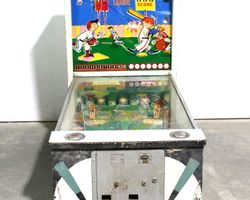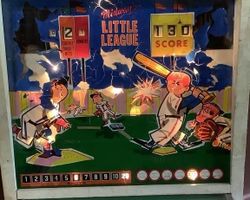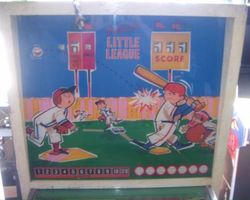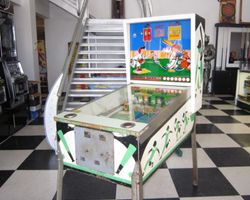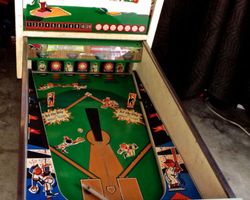Little League
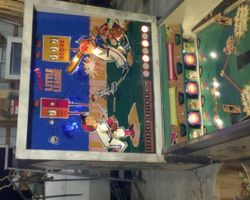
Average Prices: USD $100 to $1,000
Produced: Febuary, 1966
Machine Type: Electro-mechanical
Players: 1
Midway Manufacturing Company's "Little League" pinball machine, released in 1966, stands as a distinctive entry in the electro-mechanical (EM) era. At a time when pinball was rapidly evolving, Midway embraced a universal theme: baseball. This single-player machine, known within the industry as a "Bat Game," sought to capture the spirit of America's pastime with a blend of mechanical ingenuity and engaging design. Production commenced in February 1966, with schematic diagrams dating to early that month, indicating a swift development cycle for its market introduction. With a total production run of only 750 units, "Little League" quickly became a notable, albeit scarce, piece of pinball history. Its cabinet, advertised at 55 inches long, 25 inches wide, and 66 inches high, housed the intricate mechanics typical of EM machines, including a single bell for sound and mechanical reels for scorekeeping. An operator-adjustable backbox jack allowed for setting replay awards to 3, 4, or 5 games per 25 cents, catering to various arcade revenue models. Unpainted wood cabinets were occasionally seen, featuring a distinct green bar across the mid-playfield, suggesting potential variations in early production or promotional versions.
Signature Features and Design
"Little League" distinguished itself through its innovative playfield elements. The machine pioneered "magic-spinning targets" on both the playfield and the rear panel. Specifically, five spinning targets, designed as three "baseball" figures and two "umpire" figures, alongside four "player" hanging targets, formed the primary interactive elements. What made these targets unique was the integration of permanent magnets attached to each of the nine targets. These magnets interacted with nearby glass-encased reed switches, a sophisticated mechanism for the era. As a target moved upon impact, its attached magnet would open or close its corresponding reed switch, precisely registering the hit and triggering game events. This system offered a level of durability and responsiveness beyond what simple leaf switches might provide.
Another standout feature was the "Curve Ball," driven by an electromagnet. This mechanism could influence the ball's trajectory, adding an element of unpredictability or controlled challenge to the gameplay. The electromagnet's effect on the ball was tunable via a rheostat, allowing operators to adjust the intensity of the "curve." These unique mechanical components, particularly the magnet-activated reed switches, elevated "Little League" beyond a typical EM game, providing dynamic visual feedback and fostering a sense of a living baseball diamond. The baseball theme was subtly yet effectively integrated, with the targets themselves embodying elements of the sport, complementing the backglass and playfield artwork that depicted a classic baseball scene.
Playfield and Mechanics
The playfield of "Little League" presents a layout that, at first glance, appears straightforward, yet it conceals layers of strategic depth. The five spinning targets, representing baseballs and umpires, are strategically positioned to demand precise shots. These targets, along with the four hanging player targets, are the central focus. Successfully striking these targets is crucial for building score and advancing game objectives. The placement of these targets often requires players to master specific angles and shot power, transforming seemingly simple shots into genuine skill challenges. The playfield flow emphasizes ball control and target acquisition over high-speed action, typical of many EM designs.
The playfield artwork is steeped in the baseball theme, with vibrant illustrations that immerse the player in the ballpark environment of the mid-1960s. The score is displayed on mechanical reels in the backbox, providing a tangible sense of progression. Lighting elements are used sparingly, typical of EM machines, to highlight key scoring areas or indicate active features. The interaction between the permanent magnets on the targets and the reed switches is fundamental to the playfield mechanics, ensuring consistent and reliable registration of hits. This precise feedback system is essential for the game's core scoring and progression, making each target hit feel impactful. The playfield's design philosophy encourages repeated plays to refine accuracy and understand the nuanced reactions of the ball to the various targets and the unique "Curve Ball" feature.
Gameplay Dynamics
The gameplay of "Little League" revolves around a core objective: accumulating and collecting "bonus runs." While the fundamental premise is accessible, the path to mastering this objective reveals the machine's deceptive difficulty. Players must hit specific targets to build up a bonus, and then successfully make a designated shot to collect these accumulated runs. The challenge lies in the precision required to complete these sequences; missing the final bonus collection shot can be particularly frustrating, leading to a "maddening" sense of missed opportunity, as noted by players. This design creates a compelling risk-reward dynamic, where accumulating a large bonus feels exhilarating, but securing it requires unwavering focus.
The "Curve Ball" feature adds a layer of unpredictability and excitement to the game. Activated by an electromagnet, this feature can subtly or dramatically alter the ball's path, requiring players to adapt quickly. This dynamic element simulates the unpredictability of a real baseball game, where a pitcher's curveball can throw a batter off balance. Strategies often involve carefully managing the bonus accumulation, knowing when to commit to the bonus collection shot, and developing the skill to handle the "Curve Ball" when it activates. Despite its electro-mechanical nature, "Little League" demands a high degree of player skill and control, making each successful bonus collection or critical target hit a rewarding moment. The gameplay is a balance of anticipation, precision, and adaptation, distinguishing it from simpler games of its era.
Reception and Legacy
"Little League" garnered a generally positive reception, appreciated for its classic design and accessible theme. Its straightforward layout made it enjoyable for casual players and younger enthusiasts, serving as an excellent entry point into pinball. However, beneath this initial accessibility lay a game that was deceptively difficult. Players quickly discovered that achieving high scores and mastering the bonus run mechanic required genuine skill and precise shot-making. The challenge of hitting specific targets to build up bonus runs and then successfully making the collection shot became a central, and often challenging, aspect of the gameplay experience. The "Curve Ball" feature was a consistent highlight, contributing a unique and fun element to the machine.
A significant aspect of "Little League's" legacy is its extreme rarity. With only 750 units produced, finding a working machine today is uncommon. This scarcity has contributed to its reputation as a sought-after collectible among enthusiasts. Despite its limited numbers, its design contributed to the ongoing evolution of EM pinball. The pioneering use of permanent magnets and reed switches for target registration demonstrated a more robust and sophisticated approach to target feedback than conventional methods. While some technical issues, such as "open" paddle sensors or broken wires leading to tilt, were noted in some instances, these were typical maintenance considerations for EM machines. "Little League" stands as a testament to Midway's innovative spirit in the mid-1960s, offering a deceptively deep gameplay experience wrapped in a familiar and engaging baseball theme. Its enduring appeal lies in its blend of simplicity, challenge, and unique mechanical features, securing its place as a distinctive piece of pinball history.
Sponsored Links
 Ebay Listings
Ebay Listings
 Auction Results
Auction Results
| Cost | Location | Date |
|---|---|---|
| USD $375 |  Maryland, United States Maryland, United States |
11 August, 2022 |
| USD $2,495 |  California, United States California, United States |
20 October, 2021 |
| USD $250 |  Texas, United States Texas, United States |
29 September, 2021 |
| USD $500 |  Tennessee, United States Tennessee, United States |
22 March, 2021 |
| USD $320 |  New York, United States New York, United States |
26 November, 2017 |
| USD $1,995 |  Texas, United States Texas, United States |
27 January, 2016 |
| USD $770 |  California, United States California, United States |
04 June, 2015 |
| USD $650 |  Michigan, United States Michigan, United States |
08 June, 2014 |
| USD $1,000 |  Michigan, United States Michigan, United States |
14 October, 2013 |
| USD $365 |  Pennsylvania, United States Pennsylvania, United States |
10 December, 2012 |


Private Policy · Search Website · Contact Us
As an eBay Partner, we may earn a commission from qualifying purchases made through links on this site, at no additional cost to you.
All trademarks and copyrighted materials remain property of their respective owners. All other content copyright 2007 - 2025 Pinpedia.

